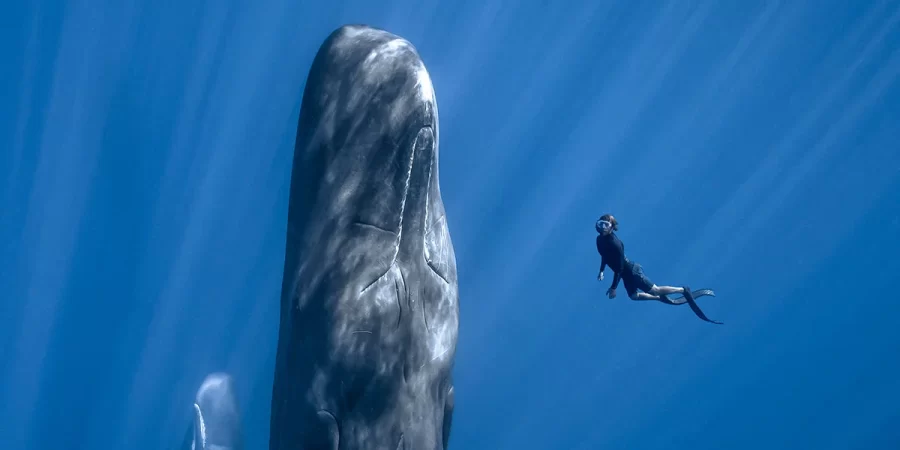Whales, Friendship, & Discovery: Filmmaker Patrick Dykstra
December 6, 2022
Patrick Dykstra’s journey to becoming an award-winning marine wildlife filmmaker started at the Smithsonian Museum of Natural History in Washington, D.C. — When he was 16, he scored a summer internship with a newly elected senator. Due to being underage, he was unable to attend all the fun parties so he spent all his time sightseeing, and it was there that he discovered the blue whale.
“I’m alive when the biggest animal to inhabit the planet is also alive,” he explained over Zoom, “I could potentially go in the ocean and swim around with one”.
Dykstra was so fascinated with the museum exhibit that when he returned home, he began extensively researching the blue whale and how to find one. But between permits, boats, and finding a team to go with you, searching for whales is really, really expensive. He needed a job that would give him the most money in as little time as possible. Ultimately, he decided on law because he could make a lot of money, invest a certain percentage of it, and eventually have a stable income purely from investments.
In 2012, after 8 years as a corporate lawyer, he quit; the partners at his firm didn’t believe him — “‘They were like ‘Everybody needs an office, you can’t just bum around the rest of your life. You’re going to get bored in a year or two and come back.’ That was 11 years ago and I’ve never thought about going back”.
Throughout his career, he has won a BAFTA in cinematography for the BBC show Blue Planet II and hosted his own show, Chasing Ocean Giants, for Discovery+. His newest project, a documentary titled Patrick and the Whale, is directed by Mark Fletcher. This fall, it premiered at the Montclair Film Festival and previously at Toronto International Film Festival and Innsbruck Nature Film Festival, among others.
But despite all his success, Dykstra still only sees it as a paid hobby.
“It was never meant to be a job. It’s still not a job for me.”
For over a decade, Dykstra used any money he was able to save to search, with success, for other types of whales in the Azores, Antarctica, and Southern California. But a trip off the Sri Lankan coast was when he met his first sperm whale, the species of whales that would become his career’s focus. Years later in 2019, he bonded with Dolores, a sperm whale from the Caribbean island of Dominica.
For Patrick and the Whale, Dykstra was approached by Academy Award-winning My Octopus Teacher producer James Reed to make a documentary about his relationship with Dolores. This would be his first film project where he would be the protagonist rather than the filmmaker. They partnered with Terra Mater Studios and recruited Mark Fletcher as director to make a journey back down to Dominica at the height of the COVID pandemic and film even more interactions between Patrick and Dolores.
But it didn’t go as planned. During their first attempt at filming, instead of lifting him up on her head, as she had done two years before, Dolores simply swam away with a large male.
“Nature documentaries aren’t easy to make,” Dykstra said, “You go out with a plan and it almost never goes exactly as you hope because wild animals will do what they want.” While his relationship with Dolores was unfortunately cut short, new whales Can Opener, Hope, and even a new calf provided a lot of material, even though the original objective of the film was lost. Nevertheless, Dykstra was happy that they were even able to find Dolores again since she has a home range of thousands of square miles
“You can’t film much world-first behavior with lions or elephants because we have them in captivity. We’ve seen everything: mating, births, their life cycle. But the ocean is such a big, unexplored mystery that a regular, old dude like me can go out and achieve things that no one else in the world has before,” he said.
But the relationships he is able to form with them say anything but that whales are so foreign. Fletcher describes the film as a love story between a pupil and his teacher and to Dykstra, the whales connect to him because of familiarity. Each time he travels out to the ocean, he brings different people. The whales are able to distinguish who is Patrick and who is somebody new.
What Dykstra has been able to do is almost a miracle and much of the content that he is publicizing with his work has never been seen on camera before. Traveling down deep enough in the ocean to witness whale life is as difficult as traveling to space. In the film, Dykstra describes whales as ‘the farthest thing to aliens we have on our own planet’: “We can’t even say basic things – how often do they sleep? How often do they sleep vertically? No idea, nobody knows,” he points out.
Sometimes, the most we see of whales is the tragedy. In a particularly striking scene in the film, Dykstra and his camera visit a beach where 10 whales lay dead due to trapping themselves on land (“beaching”). He can’t help but think about the whales that he knows, and the possibility of them ending up in the same position. There are around 2,000 whale beachings per year.
As a leading cause of whale beaching, the ever-present threat of climate change affects marine life immensely. When the ocean changes in temperature, not only do animals have to migrate to survive, but their food is also not where it’s expected to be. And even one degree can be fatal.
The idea that people don’t have the power to change the Earth is absurd to Dykstra. “There are 8 billion of us. There’s not a lot that 8 billion can’t do. We’re affecting this Earth in a major way.”
But perhaps the disconnect comes from not realizing how much these animals matter, and how similar they are to us. The objective of Patrick and the Whale, Dykstra said, was to better familiarize audiences with how much in common we have with whales. Reed believes that a human’s relationship with a marine animal parallels with emotions that we feel in our own lives, and that idea is certainly reminiscent in this film as it was in My Octopus Teacher. Dykstra’s personal arc in this documentary show disappointment and failure, but ultimately satisfaction.
“To see [Dolores] react to my reactions, and afterward the joy that gave me and seemingly her, to play with me on the surface — that’s the moment in the film that I think makes whales seem relatable to human beings.”



Deborah Tackett • Dec 10, 2022 at 9:17 pm
Kudos, great article!
Rj Klein • Feb 25, 2024 at 6:27 pm
He’s pretty freakin’ cool. Mostly his humility of understanding maybe they are not trying to tell us what we seek, but to leave them alone, their habitat, and to stop polluting their environment.